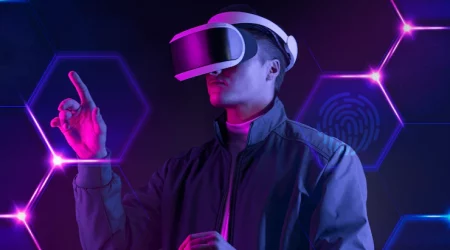Will the Metaverse Change the Way People Interact With the World?
Table of Contents
Will the Metaverse Change the Way People Interact With the World?
As virtual reality platforms and the growth of Second Life have brought a new way to interact with the world, will the Metaverse change the way people interact with it? This article explores the Metaverse and how it will impact businesses. Despite its relatively new origin, the Metaverse promises to change the way people interact with the world. It can change how we do business in the real world and bring new possibilities to the digital world.
Roblox and Minecraft are already making their mark in the virtual world. The game, which spawned the first metaverse, is so popular that it has even hosted live concerts. The likes of Travis Scott and Ariana Grande have even performed within the game. The Soundwave Series even features international musicians. Roblox and Minecraft let players create their worlds. The pandemic, along with the upcoming metaverse, is triggering a new definition of the virtual. People want to define virtual gatherings in new ways.
The first actual use for the metaverse is in virtual dating. You can “travel” to famous locations and safely participate in life-threatening extreme activities. You can literally “teleport” to a location anywhere in the world. The same technology that astronauts and pilots have used for decades to train for complex tasks. The difference is that using a virtual simulator is much cheaper than training in real life.
Social Aspects Of The Metaverse
The term “metaverse” first popped up in science fiction novels and is derived from the prefix “meta” and the word “universe.” It refers to virtual worlds where people share real-world experiences. Transactions in these worlds are often facilitated through the use of cryptocurrency. Metaverse users can wander the world freely with friends, buy goods, and even attend events. They can also teleport to their favorite places.
The Metaverse has multiple core dimensions built on the PC and mobile Internet. Various aspects of the Metaverse indicate its quality, including computing power, responsiveness, immersion, interactivity, user autonomy, and digital property protection. Its companies can focus on a particular aspect of the Metaverse, such as digital currency payment. This could make them more lucrative but also less effective in attracting users. While these aspects make Metaverse a more attractive environment, many users are reluctant to use it.
Personalizing Avatars In The Metaverse
Many users are using social media to express their identities in the current age, and personalizing avatars in the Metaverse will allow them to do just that. While social media has been plagued with negative body image issues, Meta has taken its next step in evolving its online identity with some updates and innovations. The most recent is the ability to create custom avatars for Instagram DMs and stories.
The possibilities are endless when it comes to personalizing avatars in the Metaverse. People will be able to express themselves in ways they never could before, allowing them to communicate privately and interact with other digital characters. Eventually, they may even replace the likes of Google Assistant and Siri. While these advances are exciting, they may not be enough to make avatars a true reflection of who we are as individuals.
Brands Leveraging the Metaverse
With the massive investment in NFTs by Google, Apple, Facebook, and other brands, metaverse exploration is the next creative inevitability for forward-thinking brands. It offers a hyper-personalized experience that enables a deeper connection between a brand and its customers. Furthermore, this new channel for engagement and brand recall brings global reach. Here are three ways brands can leverage the Metaverse.
The Metaverse allows multi-dimensional interactions, and brands can customize the experience based on the customer’s needs and preferences. This allows brands to develop a personal connection with customers, building brand loyalty and increasing engagement. Brands should explore the potential of metaverse to accelerate customer touchpoints. The company has already worked with several global brands to enhance the customer experience. To learn more, check out the video below.
The Metaverse is still in its early stages and may not be tangible for a while. Brands should wait to see how the technology evolves before adopting it. Early implementations indicate that brands can benefit from this technology, but it is not yet time to replace digital interactions completely. The future of advertising lies in metaverse implementations, and brands can benefit from these technologies. The technology has the potential to help brands improve customer touchpoints and create unique experiences.
Financial Aspect
Financial institutions are highly regulated, but the new metaverse economy will have different regulations. While the traditional financial sector operates with complex regulations and guidance, the new metaverse will have its economic system and finance. It will also be subject to regulatory scrutiny, which will make it essential for financial institutions to ensure they are not falling victim to cybercrime or excessive speculation.
The Metaverse is not one big virtual world but multiple virtual worlds interconnected with each other. The virtual worlds are based on digital interactions and form a user-generated ecosystem. The Metaverse has the potential to democratize access to financial services, and many institutions are currently monetizing it. This growth will create new jobs and shape the financial industry. And it will likely continue to grow in size.
Read More: How Would the Metaverse Affect Human Psychology?
Second Life’s infrastructure
Second Life’s infrastructure will be a game-changer in many ways, from how people communicate and collaborate to how they view the world and make purchases. The server and client have built-in digital rights management systems that manage the movement of textures, sounds, scripts, and models. The software enforces these rights, but the user cannot simply “download” the objects. They must first transfer the data to their computer.
When Second Life was released in June 2003, it was initially a social platform. With the global epidemic of the COVID-19 virus, people are staying home, so many businesses and educational institutions are seeking ways to collaborate and communicate without leaving the comfort of their homes. This shift has been a boon for enterprise-focused tools like video conferencing software and chat. Second Life’s infrastructure is set to change how people interact with the world.
Its Impact On Human Interaction
The impact of metaverse technology on human interaction may seem farfetched. However, major technology companies have invested billions of dollars in developing such technologies. In addition to Apple Inc., which is rumored to be launching a mixed-reality headset in 2022, Google Inc. and Alphabet Inc. also have their eyes on metaverse technology. These companies have already experimented with other virtual worlds, including Google Glass.
The emergence of centralized virtual worlds like the metaverse and virtual reality are two new developments with many potential applications. These technologies are expected to change how we interact with the real world. The impact of virtual worlds on human interaction is largely unknown, but they have already created new social networks and online communities. The metaverse will change how we interact with each other, and these innovations will shape the future of social media.








Leave a Reply